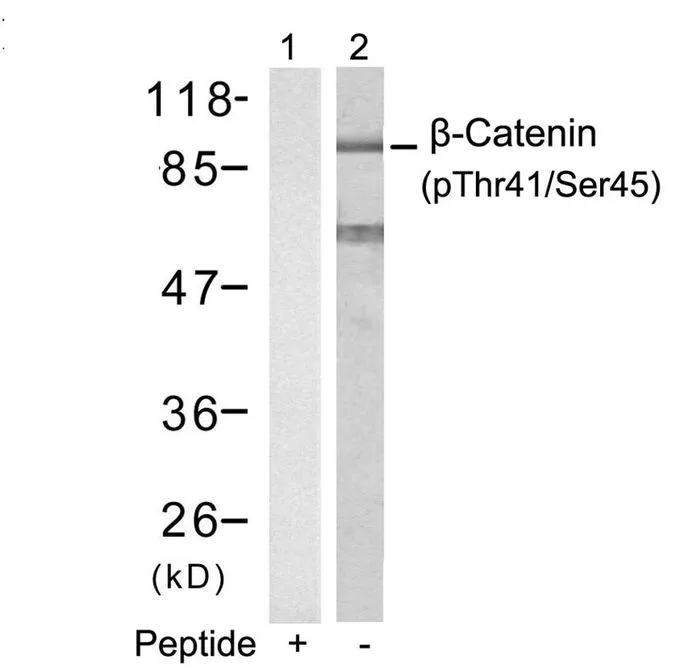
WB analysis of extracts from SW626 cells using GTX50180 beta Catenin (phospho Thr41/Ser45) antibody. Lane 1 : Primary antibody pre-incubated with the antigen specific peptide
beta Catenin (phospho Thr41/Ser45) antibody
GTX50180
ApplicationsImmunoFluorescence, Western Blot, ImmunoCytoChemistry
Product group Antibodies
ReactivityHuman
TargetCTNNB1
Overview
- SupplierGeneTex
- Product Namebeta Catenin (phospho Thr41/Ser45) antibody
- Delivery Days Customer9
- Application Supplier NoteWB: 1:500-1:1000. *Optimal dilutions/concentrations should be determined by the researcher.Not tested in other applications.
- ApplicationsImmunoFluorescence, Western Blot, ImmunoCytoChemistry
- CertificationResearch Use Only
- ClonalityPolyclonal
- Concentration1 mg/ml
- ConjugateUnconjugated
- Gene ID1499
- Target nameCTNNB1
- Target descriptioncatenin beta 1
- Target synonymsarmadillo; catenin (cadherin-associated protein), beta 1, 88kDa; catenin beta-1; CTNNB; EVR7; MRD19; NEDSDV
- HostRabbit
- IsotypeIgG
- Protein IDP35222
- Protein NameCatenin beta-1
- Scientific DescriptionThe protein encoded by this gene is part of a complex of proteins that constitute adherens junctions (AJs). AJs are necessary for the creation and maintenance of epithelial cell layers by regulating cell growth and adhesion between cells. The encoded protein also anchors the actin cytoskeleton and may be responsible for transmitting the contact inhibition signal that causes cells to stop dividing once the epithelial sheet is complete. Finally, this protein binds to the product of the APC gene, which is mutated in adenomatous polyposis of the colon. Mutations in this gene are a cause of colorectal cancer (CRC), pilomatrixoma (PTR), medulloblastoma (MDB), and ovarian cancer. Alternative splicing results in multiple transcript variants. [provided by RefSeq, Aug 2016]
- ReactivityHuman
- Storage Instruction-20°C or -80°C,2°C to 8°C
- UNSPSC12352203
References
- miR-338-3p inhibits A549 lung cancer cell proliferation and invasion by targeting AKT and beta-catenin signaling pathways. Liu J et al., 2019 Jul, Mol Med RepRead more
